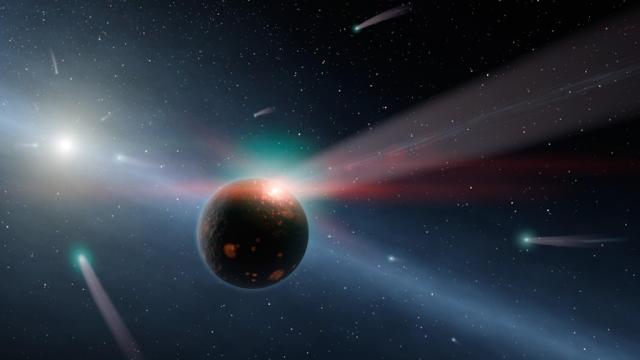Earth has some battle scars from back in the day. When the solar system was still young and wild, roughly four billion years ago, Earth, its Moon and Mars were attacked by a series of asteroid assailants. It’s long been assumed that the space rocks involved in the assault — called the Late Heavy Bombardment — are now floating around in the asteroid belt between Mars and Jupiter.
Image credit: NASA
But new research suggests there might have been another group of bullies, too. After months of running simulations on planet migration in our solar system, David Nesvorny of the Southwest Research Institute (SwRI) in Boulder, Colorado, has concluded that planetesimals — clusters of rock and dust that are basically failed planets — might have impacted Earth, the Moon and Mars during the Late Heavy Bombardment. Nesvorny’s research partner, SwRI scientist William Bottke, presented the duo’s findings at the 229th gathering of the American Astronomical Society (AAS) earlier this month.
“We think the giant planets may have started in a different configuration,” Bottke told Gizmodo, referring to Jupiter, Uranus, Saturn and Neptune. “They did migrate to their current orbits… the question is, how precisely did that happen?”
Bottke’s simulations show that when the big planets made their big move, they left some planetesimal trash behind. Those planetesimals are theoretically much more massive than the asteroids currently between Mars and Jupiter, and could be a better explanation for the huuuuuge craters found on the early Earth, and well as present-day Mars and the Moon.
Why didn’t we think of this possibility sooner? Bottke thinks that widely accepted scaling laws used to measure craters don’t accurately reflect how massive the objects that formed them really are.
“We have almost no evidence [for these scaling laws],” Bottke said. “What happens is, people take laboratory experiments where they shoot little targets with little projectiles in the lab, and they scale them up to get to how big the craters are. That’s the whole mistake, the scaling laws are wrong.”
Developing more accurate scaling numbers will help researchers like Bottke and Nesvorny gain a better understanding of the relationship between life on Earth, which began around the end of the Late Heavy Bombardment, and impact craters. It will help determine whether or not we should look for clues in the asteroid belt, or as Bottke suggests, search elsewhere.
“Did life start and then get obliterated and then make a comeback?” he said. “Or did it manage to survive this massive bombardment? How does bombardment effect our atmosphere and our biosphere?”
The answers are out there.
